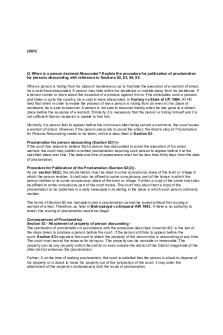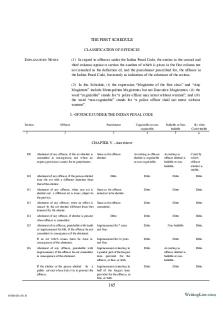Crpc Notes - Has brief details on Crpc questions and answers PDF

| Title | Crpc Notes - Has brief details on Crpc questions and answers |
|---|---|
| Course | Criminal Law - II |
| Institution | Karnataka State Law University |
| Pages | 42 |
| File Size | 570.9 KB |
| File Type | |
| Total Downloads | 504 |
| Total Views | 713 |
Summary
CRPC Q. When is a person declared Absconder? Explain the procedure for publication of proclamation for persons absconding with reference to Sections 82, 83, 84, 85. When a person is hiding from his place of residence so as to frustrate the execution of a warrant of arrest, he i...
Description
CRPC
Q. When is a person declared Absconder? Explain the procedure for publication of proclamation for persons absconding with reference to Sections 82, 83, 84, 85. When a person is hiding from his place of residence so as to frustrate the execution of a warrant of arrest, he is said have absconded. A person may hide within his residence or outside away from his residence. If a person comes to know about the issuance of a process against him or if he anticipates such a process and hides or quits the country, he is said to have absconded. In Kartary vs State of UP, 1994, All HC held that when in order to evade the process of law a person is hiding from (or even in) his place of residence, he is said to abscond. A person is not said to abscond merely when he has gone to a distant place before the issuance of a warrant. Similarly, it is necessary that the person is hiding himself and it is not sufficient that an inspector is unable to find him. Normally, if a person fails to appear before the court even after being served a summons, the court issues a warrant of arrest. However, if the person absconds to avoid the arrest, the drastic step of Proclamation for Persons Absconding needs to be taken, which is described in Section 82.. Proclamation for person absconding (Section 82(1)) If the court has reason to believe that a person has absconded to avoid the execution of his arrest warrant, the court may publish a written proclamation requiring such person to appear before it at the specified place and time. The date and time of appearance must not be less than thirty days from the date of proclamation. Procedure for Publication of the Proclamation (Section 82(2)) As per section 82(2), the proclamation must be read in some conspicious place of the town or village in which the person resides. It shall also be affixed to some conspicuous part of the house in which the person resides or to some conspicuous place of the town or village. Further, a copy of the same must also be affixed to some conspicious part of the court house. The court may also direct a copy of the proclamation to be published in a daily newspaper circulating in the place is which such person ordinarily resides. The terms of Section 82 are mandatory and a proclamation cannot be issued without first issuing a warrant of arrest. Therefore, as held in Bishnudayal vs Emperor AIR 1943, if there is no authority to arrest, the issuing of proclamation would be illegal. Consequences of Proclamation Section 83 - Attachment of property of person absconding The publication of proclamation in accordance with the procedure described in section 82, is the last of the steps taken to produce a person before the court. If the person still fails to appear before the court, Section 83 empowers the court to attach the property of the person who is absconding at any time. The court must record the reasons for doing so. The property can be movable or immovable. The property can be any property within the district or even outside the district of the District magistrate of the other district endorses the proclamation. Further, if, at the time of making proclamation, the court is satisfied that the person is about to dispose of his property or is about to move his property out of the jurisdiction of the court, it may order the attachment of the property simultaneously with the issue of proclamation.
If the property to be attached is a debt or is movable property, the attachment is done either by seizure, by the appointment of a receiver, by an order ins writing prohibiting the deliver of sch property to the proclaimed person or to anyone on his behalf. Court can also use any one or more of these modes as it thinks fit. If the property is immovable, it can be attached by taking possession, by appointing a receiver, by an order prohibiting the payment of rent to the proclaimed persons or by any or all of these methods. Section 84 provides a means to protect the interests of any person other than the proclaimed person in the attached property. Any such person who has an interest in the attached property can claim it within six months from the date of attachment on the ground that the claimant has an interest in the property and the interest is not liable to be attached under section 83. The claim shall be inquired into and may be allowed or disallowed in whole or in part. (1) If any claim is preferred to, or objection made to the attachment of, any property attached under section 83, within six months from the date of such attachment, by any person other than the proclaimed person, on the ground that the claimant or objector has an interest in such property, and that such interest is not liable to attachment under section 83, the claim or objection shall be inquired into, and may be allowed or disallowed in whole or in part: Provided that any claim preferred or objection made within the period allowed by this sub-section may, in the event of the death of the claimant or objector, be continued by his legal representative. (2) Claims or objections under sub-section (1) may be preferred or made in the Court by which the order of attachment is issued, or, if the claim or objection is in respect of property attached under an order endorsed under sub-section (2) of section 83, in the Court of the Chief Judicial Magistrate of the district in which the attachment is made. (3) Every such claim or objection shall be inquired into by the Court in which it is preferred or made: Provided that, if it is preferred or made in the Court of a Chief Judicial Magistrate, he may make it over for disposal to any Magistrate subordinate to him. (4) Any person whose claim or objection has been disallowed in whole or in part by an order under subsection (1) may, within a period of one year from the date of such order, institute a suit to establish the right which he claims in respect of the property in dispute; but subject to the result of such suit, if any, the order shall be conclusive. Section 85 - Release, Sale, and restoration of the property (1) If the proclaimed person appears within the time specified in the proclamation, the Court shall make an order releasing the property from the attachment. (2) If the proclaimed person does not appear within the time specified in the proclamation, the property under the attachment shall be at the disposal of the State Government; but it shall not be sold until the expiration of six months from the date of the attachment and until any claim preferred or objection made under section 84 has been disposed of under that section, unless it is subject to speedy and natural decay, or the Court considers that the sale would be for the benefit of the owner; in either of which cases the Court may cause it to be sold whenever it thinks fit. (3) If, within two years from the date of the attachment, any person whose property is or has been at the disposal of the State Government, under sub-section (2), appears voluntarily or is apprehended and brought before the Court by whose order the property was attached, or the Court to which such Court is subordinate, and proves to the satisfaction of such Court that he did not abscond or conceal himself for the purpose of avoiding execution of the warrant, and that he had not such notice of the proclamation as to enable him to attend within the time specified therein such property, or, if the same has been sold, the net proceeds of the sale, or, if part only thereof has been sold, the net proceeds of the sale, and the residue of the property, shall, after satisfying therefrom all costs incurred in consequence of the attachment, be delivered to him.
Arrest
Q. What do you understand by Arrest? How is an arrest made? When can the police arrest a person without an order from a magistrate and/or without a warrant? Explain the rights of an arrested person. [Right to know the grounds of arrest - Art 22(1), Sec 50, 50(A), Right to consult and to be defended by legal practitioner of his choice - Art 22(1), Sec 303, Right to legal aid - Art 21, Sec 304, Right to bail Sec 50(2), Right to be produced before nearest magistrate within 24 hrs Art 22(2) Sec 56, 57, Right not to be detained in custody beyond 24 hrs - Art 22(2) Sec 57, 167, Right to be examined by medical practitioner] Arrest means apprehension of a person by legal authority so as to cause deprivation of his liberty. Thus, after arrest, a person's liberty is in control of the arrester. Arrest is an important tool for bringing an accused before the court as well as to prevent a crime or prevent a person suspected of doing crime from running away from the law. Cr P C contemplates two types of arrests - an arrest that is made for the execution of a warrant issued by a magistrate and an arrest that is made without any warrant but in accordance with some legal provision that permits arrest. Section 41 to 44 contain provisions that govern the arrest of a person by police and private citizens, while Section 46 describes how an arrest is a made. (Note - Arrest in case of Warrant is discussed in another question.) Arrest without warrant There are situations when a person may be arrested by a police officer, a magistrate or even private citizen without a warrant. These are described in Section 41, 42, 43, and 44 as follows Arrest by Police - Section 41. When police may arrest without warrant (CIPSODOBO) (1) Any police officer may without an order from a Magistrate and without a warrant, arrest any person (a) who has been concerned in any cognizable offence, or against whom a reasonable complaint has been made, or credible information has been received, or a reasonable suspicion exists, of his having been so concerned; or (b) who has in his possession without lawful excuse, the burden of proving which excuse shall lie on such person, any implement of house-breaking; or (c) who has been proclaimed as an offender either under this Code or by order of the State Government; or (d) in whose possession anything is found which may reasonably be suspected to be stolen property and who may reasonably be suspected of having committed an offence with reference to such thing; or (e) who obstructs a police officer while in the execution of his duty, or who has escaped, or attempts to escape, from lawful custody; or (f) who is reasonably suspected of being a deserter from any of the Armed Forces of the Union; or (g) who has been concerned in, or against whom a reasonable complaint has been made, or credible information has been received, or a reasonable suspicion exists, of his having been concerned in, any act committed at any place out of India which, if committed in India, would have been punishable as an offence, and for which he is, under any law relating to extradition, or otherwise, liable to be apprehended or detained in custody in India; or (h) who, being a released convict, commits a breach of any rule made under sub-section (5) of section 356; or (I) for whose arrest any requisition, whether written or oral, has been received from another police officer, provided that the requisition specifies the person to be arrested and the offence or other cause for which the arrest is to be made and it appears therefrom that the person might lawfully be arrested without a warrant by the officer who issued the requisition.
(2) Any officer in charge of a police station may, in like manner, arrest or cause to be arrested any person, belonging to one or more of the categories of persons specified in section 109 or section 110. In the case of Joginder Kumar vs State of UP, CrLJ, 1994, it was held that no arrest can be made merely because it is lawful to do so. There must be a justifiable reason to arrest. Further, in State vs Bhera, CrLJ, 1997, it was held that the "reasonable suspicion" and "creditable information" must relate to definite averments which must be considered by the Police Officer himself before he arrests the person.
Section 42 allows a police officer to arrest a person for a non-cognizable offence, if he refuses to give his name and residence. As per Section 42(1), when any person who, in the presence of a police officer, has committed or has been accused of committing a non-cognizable offence refuses, on demand of such officer, to give his name and residence or gives a name or residence which such officer has reason to believe to be false, he may be arrested by such officer in order that his name or residence may be ascertained. However, as per sub clause (2), the person must be released when the true name and residence of such person have been ascertained. He may be required to execute a bond, with or without sureties, to appear before a Magistrate if necessary. Provided that, if such person is not resident in India, the bond shall be secured by a surety or sureties resident in India. Further, as per sub clause (3), should the true name and residence of such person not be ascertained within twenty-four hours from the time of arrest or should he fail to execute the bond, or, if so required, to furnish sufficient sureties, he shall forthwith be forwarded to the nearest Magistrate having jurisdiction. Arrest by Private person Even private persons are empowered to arrest a person for protection of peace in certain situations. This is important because police cannot be present at every nook and corner and it is up to private citizens to protect the society from disruptive elements or criminals. As per section 43(1), any private person may arrest or cause to be arrested any person who in his presence commits a non-bailable and cognizable offence, or any proclaimed offender, and, without unnecessary delay, shall make over or cause to be made over any person so arrested to a police officer, or, in the absence of a police officer, take such person or cause him to be taken in custody to the nearest police station. Thus, if a person is drunk and is committing assault on others, he may be rightly arrested by any citizen and taken to the nearest police station. However, it is important to note that this power can be exercised only when the person making an arrest is under a bona fide impression that a non-bailable and cognizable office is being committed in his presence. One does not have a right to arrest on mere suspicion or on mere opinion that an offence has been committed. Procedure on arrest by private person As mentioned above, the private person must take the arrested person to the police officer or police station without any reasonable delay. If he keeps the person in his own custody, he will be guilty of wrongful confinement as given in Section 342 of IPC. As per section 43(2), If there is reason to believe that such person comes under the provisions of section 41, a police officer shall re-arrest him. Further, as per section 43(3), if there is reason to believe that he has committed a non-cognizable offence, and he refuses on the demand of a police officer to give his name and residence, or gives a name or residence which such officer has reason to believe to be false, he shall be dealt with under the provisions of section 42; but if there is no sufficient reason to believe that he has committed any offence, he shall be at once released. A new provision has been incorporated as Section 50A, which makes it obligatory for the police officer or any other person making an arrest to give the information regarding such arrest and place where the arrested person is being held to any of his friends, relatives or such other persons as may be disclosed or
nominated by the arrested person for the purpose of giving such information. Further, the police officer shall inform the arrested person of his rights under subsection as soon as he is brought to the police station. He must make an entry of the fact as to who has been informed of the arrest of such person in a book to be kept in the police station in such form as may be prescribed in this behalf by the State Government. It is the duty of the Magistrate before whom such arrested person is produced, to satisfy himself that the requirements of this section has been complied with in respect of such arrested person. Arrest by Magistrate As per Section 44(1), when any offence is committed in the presence of a Magistrate, whether Executive or Judicial, within his local jurisdiction, he may himself arrest or order any person to arrest the offender, and may thereupon, subject to the provisions herein contained as to bail, commit the offender to custody. Further, (2) Any Magistrate, whether Executive or Judicial, may at any time arrest or direct the arrest, in his presence, within his local jurisdiction, of any person for whose arrest he is competent at the time and in the circumstances to issue a warrant. Important thing to note here is that magistrates have wider power than private citizen. A magistrate can arrest on the ground of any offence and not only on cognizable offence. As held in the case of Swami Hariharanand Saraswati vs Jailer I/C Dist. Varanasi, AIR 1954, the arrested person must be produced before another magistrate within 24 hours, otherwise his detention will be illegal. Arrest how made Section 46 describes the way in which an arrest is actually made. As per Section 46(1), unless the person being arrested consents to the submission to custody by words or actions, the arrester shall actually touch or confine the body of the person to be arrested. Since arrest is a restraint on the liberty of the person, it is necessary for the person being arrested to either submit to custody or the arrester must touch and confine his body. Mere oral declaration of arrest by the arrester without getting submission to custody or physical touching to confine the body will not amount to arrest. The submission to custody may be by express words or by action. For example, as held in the case of Bharosa Ramdayal vs Emperor AIR 1941, if a person makes a statement to the police accusing himself of committing an offence, he would be considered to have submitted to the custody of the police officer. Similarly, if the accused proceeds towards the police station as directed by the police officer, he has submitted to the custody. In such cases, physical contact is not required. In case of Birendra Kumar Rai vs Union of India, CrLJ, 1992, it was held that arrest need not be by handcuffing the person, and it can also be complete by spoken words if the person submits to custody. Section 46(2) If such person forcibly resists the endeavor to arrest him, or attempts to evade the arrest, such police officer or other person may use all means necessary to effect the arrest. Thus, if the person tries to runaway, the police officer can take actions to prevent his escape and in doing so, he can use physical force to immobilize the accused. However, as per Section 46(3), there is no right to cause the death of the person who is not accused of an offence punishable with death or with imprisonment for life, while arresting that person. Further, as per Section 49, an arrested person must not be subjected to more restraint than is necessary to prevent him from escaping. Due to concerns of violation of the rights of women, a new provision was inserted in Section 46(4) that forbids the arrest of women after sunset and before sunrise, except in exceptional circumstances, in which case the arrest can be done by a woman police officer after making a written report and obtaining a prior permission from the concerned Judicial Magistrate of First class. In Kultej Singh vs Circle Inspector of Police, 1992, it was held that keeping a person in the police station or confining the movement of the person in the precincts of the police station amounts to arrest of the person.
Rights of an Arrested person (GBMLLIM) Cr P C gives wide powers to the police for arresting a person. Such powers without appropriate
safeguards for the arrested person will be harmful for the society. To ensure that this power is not used arbitrarily, several restraints have been put on it, which, indirectly, can be seen as recognition of the rights of a person being arrested. Further, once arrested, a person is already at a disadvantage because of his lack of freedom and so he cannot take appropriate steps to defend himself. Thus, to meet the needs of "fair trial", several provisions are g...
Similar Free PDFs
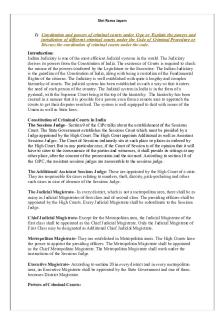
Crpc brief understanding
- 47 Pages
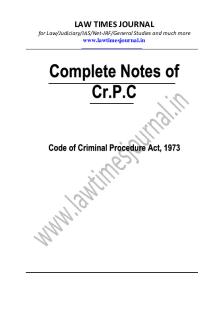
Crpc complete notes pdf
- 117 Pages
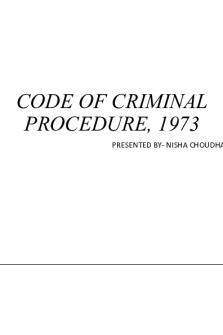
CRPC - Cr.P.C Lecture Notes
- 141 Pages
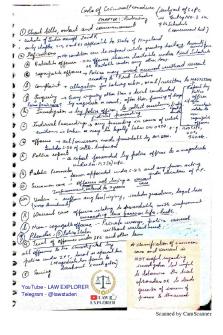
Crpc Handwritten Notes
- 41 Pages

CRPC Notes for Exams
- 117 Pages

See law Crpc mcqs
- 11 Pages

Section 6 Cr PC - Notes of CrPC
- 7 Pages

Law on sales questions - Answers
- 2 Pages
Popular Institutions
- Tinajero National High School - Annex
- Politeknik Caltex Riau
- Yokohama City University
- SGT University
- University of Al-Qadisiyah
- Divine Word College of Vigan
- Techniek College Rotterdam
- Universidade de Santiago
- Universiti Teknologi MARA Cawangan Johor Kampus Pasir Gudang
- Poltekkes Kemenkes Yogyakarta
- Baguio City National High School
- Colegio san marcos
- preparatoria uno
- Centro de Bachillerato Tecnológico Industrial y de Servicios No. 107
- Dalian Maritime University
- Quang Trung Secondary School
- Colegio Tecnológico en Informática
- Corporación Regional de Educación Superior
- Grupo CEDVA
- Dar Al Uloom University
- Centro de Estudios Preuniversitarios de la Universidad Nacional de Ingeniería
- 上智大学
- Aakash International School, Nuna Majara
- San Felipe Neri Catholic School
- Kang Chiao International School - New Taipei City
- Misamis Occidental National High School
- Institución Educativa Escuela Normal Juan Ladrilleros
- Kolehiyo ng Pantukan
- Batanes State College
- Instituto Continental
- Sekolah Menengah Kejuruan Kesehatan Kaltara (Tarakan)
- Colegio de La Inmaculada Concepcion - Cebu
